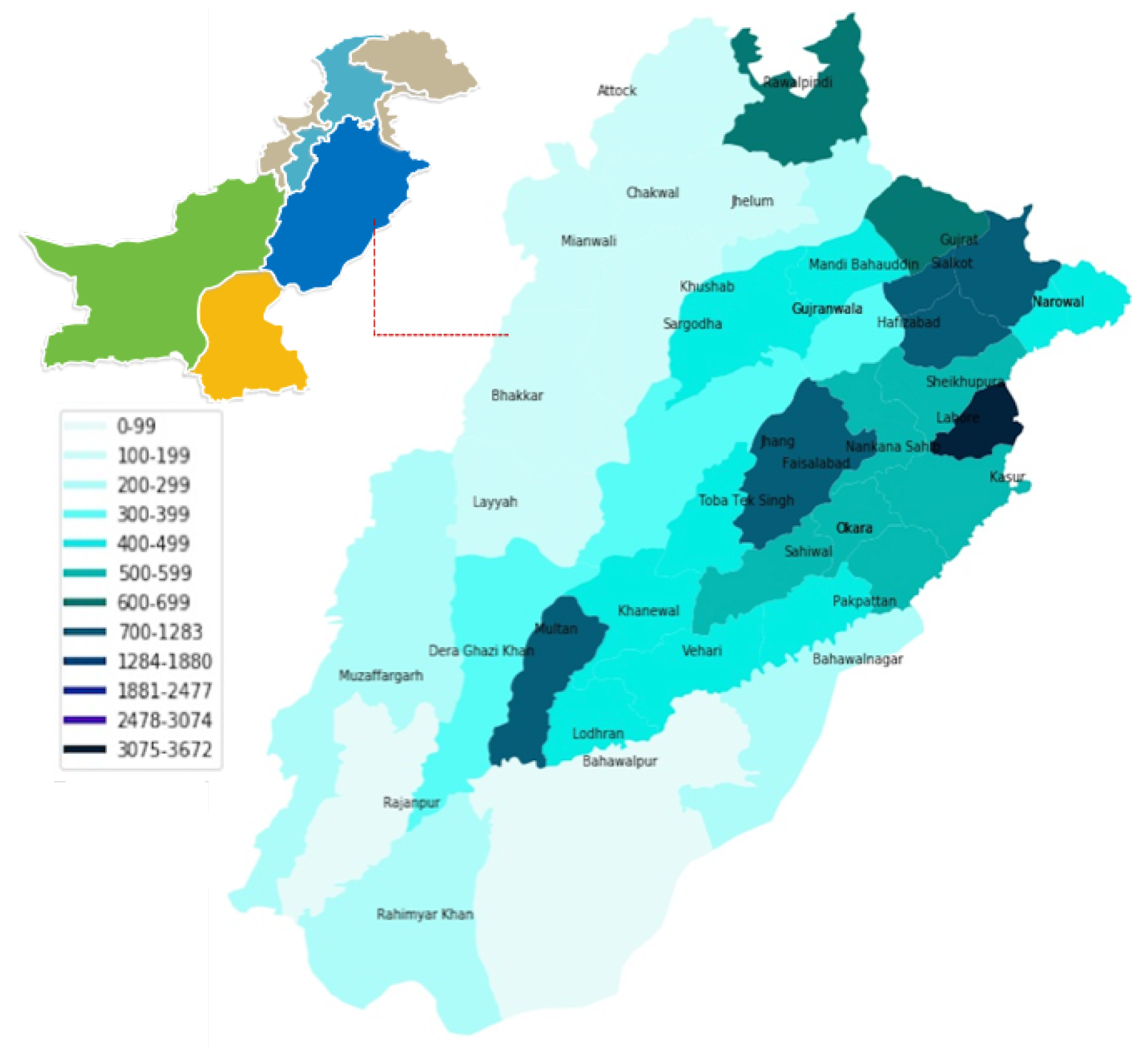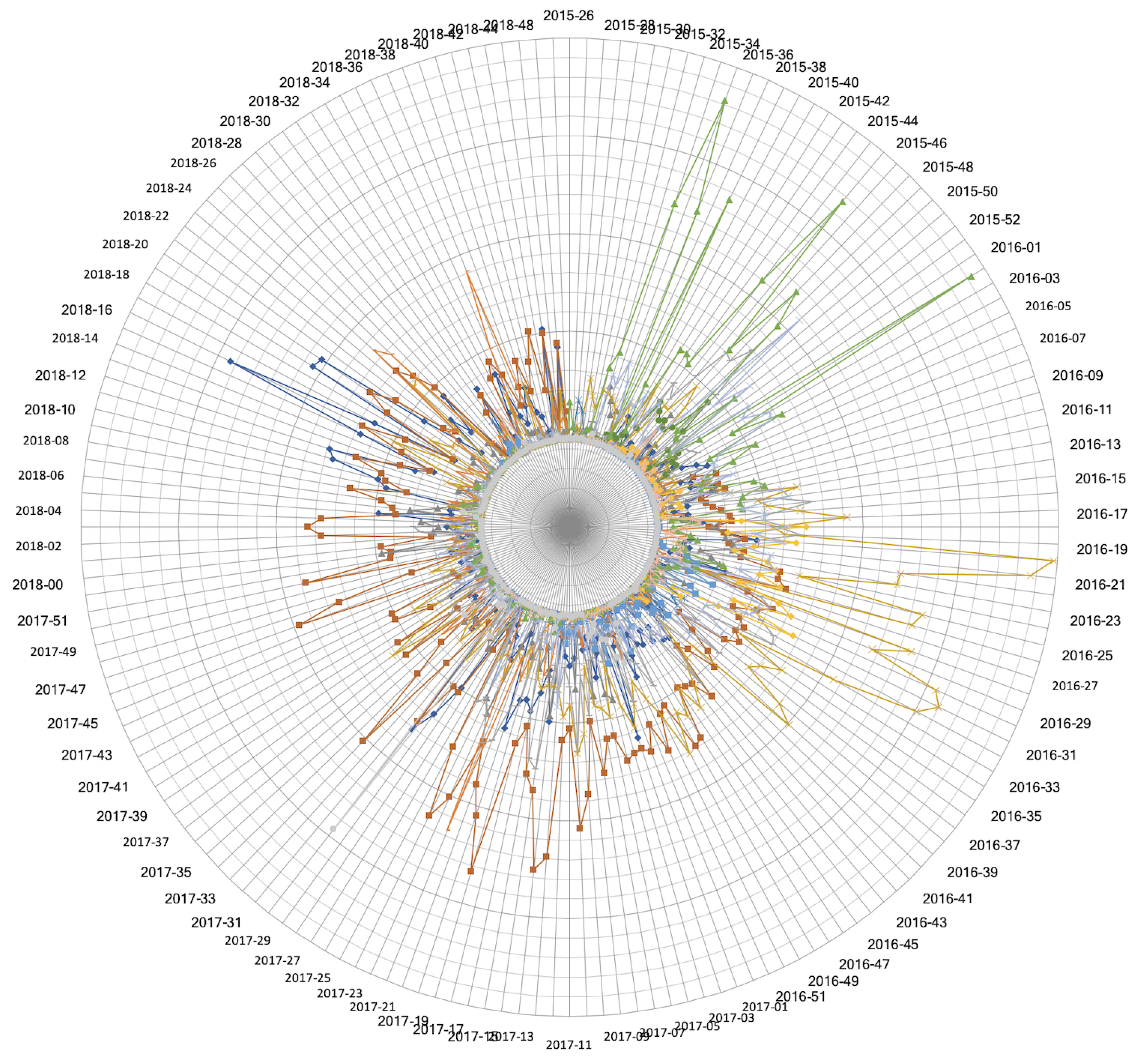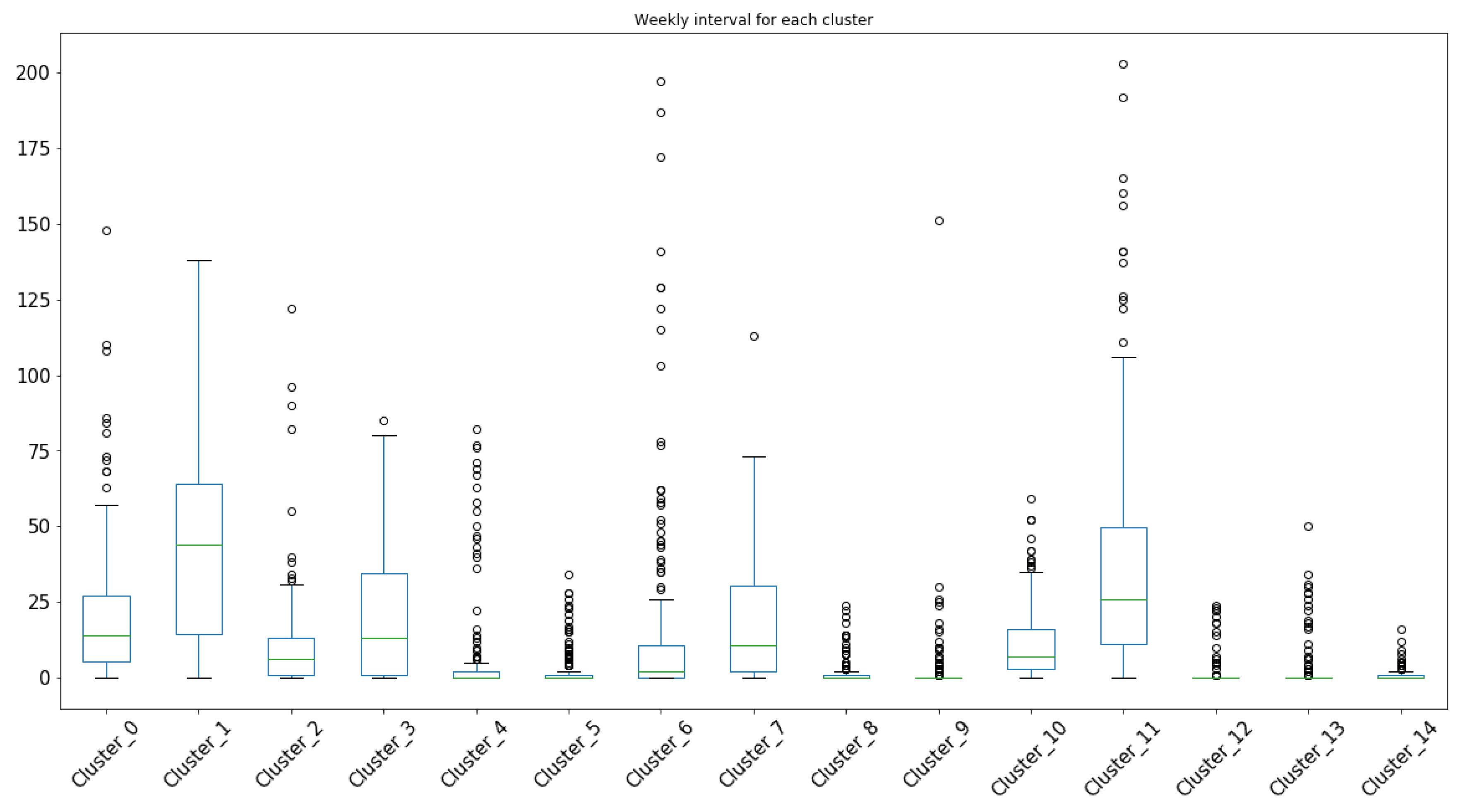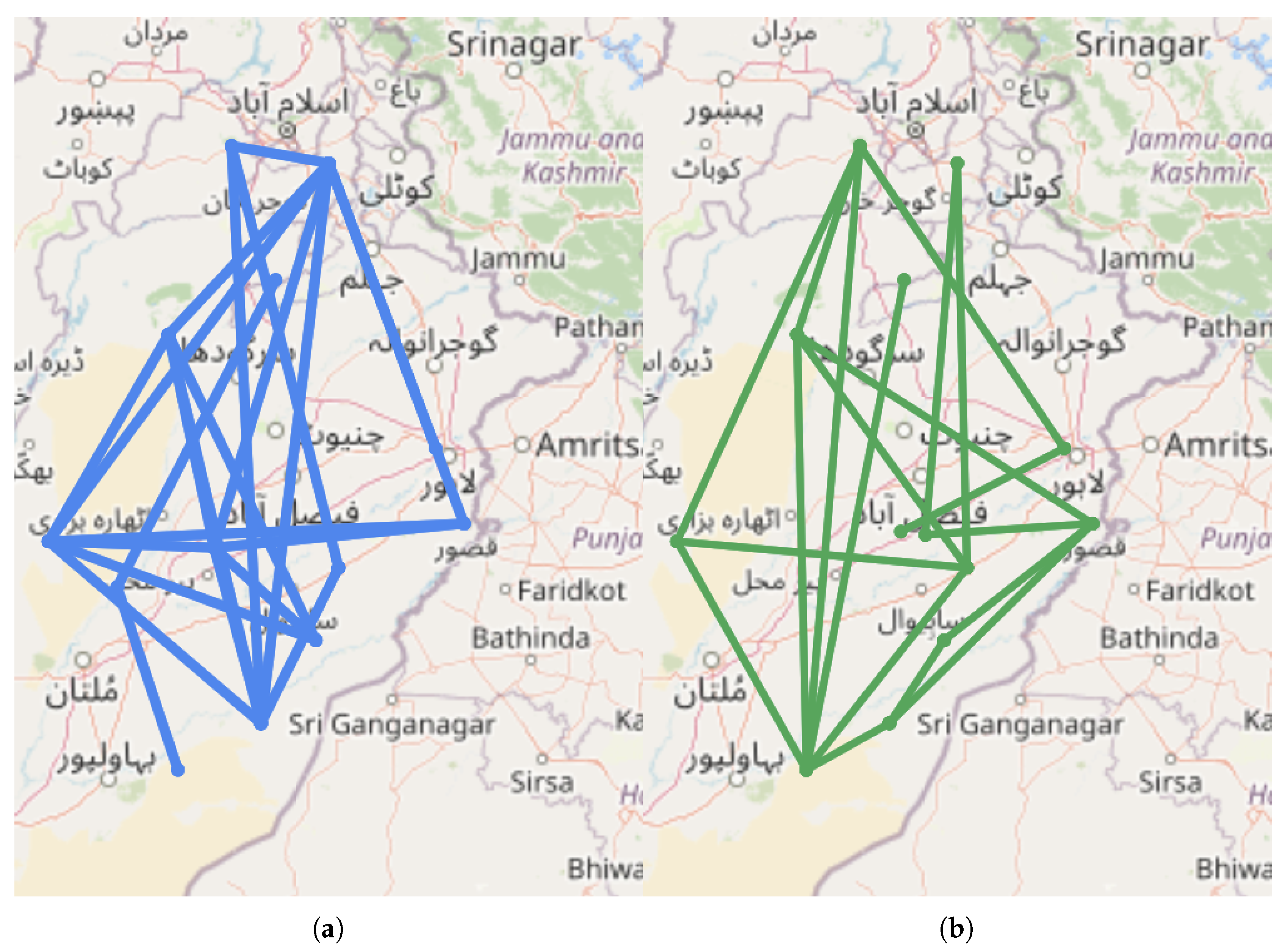An Integrated Approach for Spatio-Temporal Cholera Disease Hotspot Relation Mining for Public Health Management in Punjab, Pakistan
Abstract
1. Introduction
2. Related Work
3. Methods and Materials
3.1. Study Area
3.2. Dataset
3.3. Disease Management Model
3.3.1. Hotspot Detection
3.3.2. Correlation Based Factor Selection
3.3.3. Intgrating Spatio-Temporal and Determinant Factors
3.3.4. Feature Based Hotspot Relation Mining
4. Results and Discussion
5. Conclusions
Author Contributions
Funding
Conflicts of Interest
References
- Dash, S.; Shakyawar, S.; Sharma, M.; Kaushik, S. Big data in healthcare: Management, analysis and future prospects. J. Big Data 2019, 6, 54. [Google Scholar] [CrossRef]
- Bansal, S.; Chowell, G.; Simonsen, L.; Vespignani, A.; Viboud, C. Big Data for Infectious Disease Surveillance and Modeling. J. Infect. Dis. 2016, 214, S375–S379. [Google Scholar] [CrossRef] [PubMed]
- Hay, S.I.; George, D.B.; Moyes, C.L.; Brownstein, J.S. Big Data Opportunities for Global Infectious Disease Surveillance. PLoS Med. 2013, 10, e1001413. [Google Scholar] [CrossRef] [PubMed]
- Shin, D.; Biocca, F. Health Experience Model of Personal Informatics: The Case of a Quantified Self. Comput. Hum. Behav. 2017, 69, 62–74. [Google Scholar] [CrossRef]
- Raghupathi, W.; Raghupathi, V. Big data analytics in healthcare: Promise and potential. Health Inf. Sci. Syst. 2014, 2, 3. [Google Scholar] [CrossRef]
- Shin, D.; Lee, S.; Hwang, Y. How do credibility and utility play in the user experience of health informatics services? Comput. Hum. Behav. 2017, 67, 292–302. [Google Scholar] [CrossRef]
- Khalique, F.; Khan, S.; Nosheen, I. PHF-A Framework for Public Health Monitoring, Analytics and Research. IEEE Access 2019, 7, 101309–101326. [Google Scholar] [CrossRef]
- Khalique, F.; Khan, S.A.; ul Ain Mubarak, Q.; Safdar, H. Decision Tree-Based Anonymized Electronic Health Record Fusion for Public Health Informatics. In Intelligent Computing; Springer: Cham, Switzerland, 2018. [Google Scholar]
- Park, Y.J.; Shin, D. Contextualizing privacy on health-related use of information technology. Comput. Hum. Behav. 2019, 105, 106204. [Google Scholar] [CrossRef]
- Pickle, L.W. Spatial Analysis of Disease. In Biostatistical Applications in Cancer Research; Beam, C., Ed.; Springer: Boston, MA, USA, 2002; pp. 113–150. [Google Scholar] [CrossRef]
- Chen, D. Modeling the Spread of Infectious Diseases: A Review. In Analyzing and Modeling Spatial and Temporal Dynamics of Infectious Diseases; Chen, D., Moulin, B., Wu, J., Eds.; Wiley: Hoboken, NJ, USA, 2014; pp. 19–42. [Google Scholar] [CrossRef]
- Bailey, N.T. The Biomathematics of Malaria; Charles Griffin & Company Ltd.: London, UK, 1982; pp. 93–95. [Google Scholar]
- Singh, S.; Shukla, J.B.; Chandra, P. Mathematical modeling and analysis of the spread of carrier dependent infectious diseases: Effects of cumulative density of environmental factors. Int. J. Biomath. 2009, 2, 213–228. [Google Scholar] [CrossRef]
- Shin, D.; Zhong, B.; Biocca, F.A. Beyond user experience: What constitutes algorithmic experiences? Int. J. Inf. Manag. 2020, 52, 102061. [Google Scholar] [CrossRef]
- Keeling, M.; Eames, K. Networks and Epidemic Models. J. R. Soc. Interface/R. Soc. 2005, 2, 295–307. [Google Scholar] [CrossRef] [PubMed]
- Schaposnik, L.P.; Zhang, A. Modelling epidemics on d-cliqued graphs. Lett. Biomath. 2018, 5, 49–69. [Google Scholar] [CrossRef]
- Seibold, C.; Callender, H.L. Modeling epidemics on a regular tree graph. Lett. Biomath. 2016, 3, 59–74. [Google Scholar] [CrossRef][Green Version]
- Ganasegeran, K.; Abdulrahman, S. Artificial Intelligence Applications in Tracking Health Behaviors During Disease Epidemics. In Human Behaviour Analysis Using Intelligent Systems; Springer: Cham, Switzerland, 2020; pp. 141–155. [Google Scholar] [CrossRef]
- Shaban-Nejad, A.; Michalowski, M.; Buckeridge, D. Health intelligence: How Artificial Intelligence Transforms Population and Personalized Health. Nat. Med. 2018. [Google Scholar] [CrossRef]
- Uddin, S.; Khan, A.; Hossain, M.E.; Moni, M.A. Comparing different supervised machine learning algorithms for disease prediction. BMC Med. Inform. Decis. Mak. 2019, 19, 1–16. [Google Scholar] [CrossRef]
- Tai, A.; Albuquerque, A.F.; Carmona, N.E.; Subramanieapillai, M.; Cha, D.S.; Sheko, M.; Lee, Y.; Mansur, R.B.; McIntyre, R.S. Machine learning and big data: Implications for disease modeling and therapeutic discovery in psychiatry. Artif. Intell. Med. 2019, 99, 101704. [Google Scholar] [CrossRef]
- Peiffer-Smadja, N.; Rawson, T.; Ahmad, R.; Buchard, A.; Pantelis, G.; Lescure, F.X.; Birgand, G.; Holmes, A. Machine learning for clinical decision support in infectious diseases: A narrative review of current applications. Clin. Microbiol. Infect. 2020, 26, 584–595. [Google Scholar] [CrossRef]
- Reluga, T.C. Game Theory of Social Distancing in Response to an Epidemic. PLoS Comput. Biol. 2010, 6, e1000793. [Google Scholar] [CrossRef]
- Poletti, P.; Ajelli, M.; Merler, S. Risk perception and effectiveness of uncoordinated behavioral responses in an emerging epidemic. Math. Biosci. 2012, 238, 80–89. [Google Scholar] [CrossRef]
- Chang, S.L.; Piraveenan, M.; Pattison, P.; Prokopenko, M. Game theoretic modelling of infectious disease dynamics and intervention methods: A review. J. Biol. Dyn. 2020, 14, 57–89. [Google Scholar] [CrossRef]
- Gaudart, J.; Moore, S.; Rebaudet, S.; Piarroux, M.; Barrais, R.; Boncy, J.; Piarroux, R. Environmental Factors Influencing Epidemic Cholera. Am. J. Trop. Med. Hyg. 2013, 89, 1228–1230. [Google Scholar] [CrossRef] [PubMed][Green Version]
- Xu, M.; Cao, C.; Wang, D.; Kan, B. Identifying Environmental Risk Factors of Cholera in a Coastal Area with Geospatial Technologies. Int. J. Environ. Res. Public Health 2014, 12, 354–370. [Google Scholar] [CrossRef] [PubMed]
- Sedas, V. Influence of environmental factors on the presence of Vibrio cholerae in the marine environment: A climate link. J. Infect. Dev. Ctries. 2007, 1, 224–241. [Google Scholar] [CrossRef] [PubMed]
- Chen, K.; Liu, X.; Ding, L.; Huang, G.; Li, Z. Spatial Characteristics and Driving Factors of Provincial Wastewater Discharge in China. Int. J. Environ. Res. Public Health 2016, 13, 1221. [Google Scholar] [CrossRef]
- Chen, B.; Zhu, Z.; Chen, F.; Zhao, Y.; Qiu, X. Strategically Patrolling in a Chemical Cluster Addressing Gas Pollutants’ Releases through a Game-Theoretic Model. Int. J. Environ. Res. Public Health 2019, 16, 612. [Google Scholar] [CrossRef]
- Benes, V.; Bodlák, K.; Jesper, M.; Rasmus, W. A case study on point process modelling in disease mapping. Image Anal. Stereol. 2005, 24, 159–168. [Google Scholar] [CrossRef]
- Spatial Point Pattern Analysis. In Applied Spatial Data Analysis with R; Springer: New York, NY, USA, 2008; pp. 155–190. [CrossRef]
- Shi, Z.; Pun-Cheng, L.S. Spatiotemporal Data Clustering: A Survey of Methods. ISPRS Int. J. Geo-Inf. 2019, 8, 112. [Google Scholar] [CrossRef]
- Ahn, J.; Johnson, T.D.; Bhavnani, D.; Eisenberg, J.N.; Mukherjee, B. A space-time point process model for analyzing and predicting case patterns of diarrheal disease in northwestern Ecuador. Spat. Spatiotemporal Epidemiol. 2014, 9, 23–35. [Google Scholar] [CrossRef]
- Barro, A.S.; Kracalik, I.T.; Malania, L.; Tsertsvadze, N.; Manvelyan, J.; Imnadze, P.; Blackburn, J.K. Identifying hotspots of human anthrax transmission using three local clustering techniques. Appl. Geogr. 2015, 60, 29–36. [Google Scholar] [CrossRef]
- Chandola, V.; Vatsavai, R.; Kumar, D.; Ganguly, A. Analyzing Big Spatial and Big Spatiotemporal Data: A Case Study of Methods and Applications. Handb. Stat. 2015, 33, 239–258. [Google Scholar] [CrossRef]
- Kim, Y.L. Data-driven approach to characterize urban vitality: How spatiotemporal context dynamically defines Seoul’s nighttime. Int. J. Geogr. Inf. Sci. 2020, 34, 1235–1256. [Google Scholar] [CrossRef]
- Chen, Y.; Ong, J.H.Y.; Rajarethinam, J.; Yap, G.; Ng, L.C.; Cook, A.R. Neighbourhood level real-time forecasting of dengue cases in tropical urban Singapore. BMC Med. 2018, 16, 1–13. [Google Scholar] [CrossRef] [PubMed]
- Lee, I.; Estivill-Castro, V. Exploration of Massive Crime Data Sets through Data Mining Techniques. Appl. Artif. Intell. 2011, 25, 362–379. [Google Scholar] [CrossRef]
- Hu, Y.; Wang, F.; Guin, C.; Zhu, H. A spatio-temporal kernel density estimation framework for predictive crime hotspot mapping and evaluation. Appl. Geogr. 2018, 99, 89–97. [Google Scholar] [CrossRef]
- Nakaya, T.; Yano, K. Visualising Crime Clusters in a Space-time Cube: An Exploratory Data-analysis Approach Using Space-time Kernel Density Estimation and Scan Statistics. Trans. GIS 2010, 14, 223–239. [Google Scholar] [CrossRef]
- Marco, M.; López-Quílez, A.; Conesa, D.; Gracia, E.; Lila, M. Spatio-Temporal Analysis of Suicide-Related Emergency Calls. Int. J. Environ. Res. Public Health 2017, 14, 735. [Google Scholar] [CrossRef]
- Kisa, A.; Network, G.; Alipour, V.; Gad, M.; Rabiee, N.; El Tantawi, M.; Cevik, M.; Banach, M.; Ayanore, M.; Skryabin, V.; et al. Health sector spending and spending on HIV/AIDS, tuberculosis, and malaria, and development assistance for health: Progress towards Sustainable Development Goal 3. Lancet 2020. [Google Scholar] [CrossRef]
- Rawassizadeh, R.; Dobbins, C.; Akbari, M.; Pazzani, M. Indexing Multivariate Mobile Data through Spatio-Temporal Event Detection and Clustering. Sensors 2019, 19, 448. [Google Scholar] [CrossRef]
- Feng, Y.; Chen, L.; Chen, X. The impact of spatial scale on local Moran’s I clustering of annual fishing effort for Dosidicus gigas offshore Peru. Chin. J. Oceanol. Limnol. 2019, 37, 330–343. [Google Scholar] [CrossRef]
- Getis, A.; Ord, J.K. The analysis of spatial association by use of distance statistics. In Perspectives on Spatial Data Analysis; Springer: New York, NY, USA, 2010; pp. 127–145. [Google Scholar]
- Goovaerts, P.; Jacquez, G.M. Detection of temporal changes in the spatial distribution of cancer rates using local Moran’s I and geostatistically simulated spatial neutral models. J. Geogr. Syst. 2005, 7, 137–159. [Google Scholar] [CrossRef]
- Tang, Z.Z.; Lin, D.Y. MASS: Meta-analysis of score statistics for sequencing studies. Bioinformatics 2013, 29, 1803–1805. [Google Scholar] [CrossRef][Green Version]
- Khedher, L.; Ramírez, J.; Górriz, J.M.; Brahim, A.; Illán, I.A. Independent Component Analysis-Based Classification of Alzheimer’s Disease from Segmented MRI Data. In Artificial Computation in Biology and Medicine; Ferrández Vicente, J.M., Álvarez-Sánchez, J.R., de la Paz López, F., Toledo-Moreo, F.J., Adeli, H., Eds.; Springer: Cham, Switzerland, 2015; pp. 78–87. [Google Scholar]
- Shekhar, S.; Jiang, Z.; Ali, R.; Eftelioglu, E.; Tang, X.; Gunturi, V.; Zhou, X. Spatiotemporal Data Mining: A Computational Perspective. ISPRS Int. J. Geo-Inf. 2015, 4, 2306–2338. [Google Scholar] [CrossRef]
- Atluri, G.; Karpatne, A.; Kumar, V. Spatio-Temporal Data Mining: A Survey of Problems and Methods. ACM Comput. Surv. 2018, 51, 1–41. [Google Scholar] [CrossRef]
- Chretien, J.P.; Swedlow, D.; Eckstrand, I.; George, D.; Johansson, M.; Huffman, R.; Hebbeler, A. Advancing epidemic prediction and forecasting: A new US government initiative. Online J. Public Health Inform. 2015, 7, e13. [Google Scholar] [CrossRef]
- He, Z.; Deng, M.; Cai, J.; Xie, Z.; Guan, Q.; Yang, C. Mining spatiotemporal association patterns from complex geographic phenomena. Int. J. Geogr. Inf. Sci. 2020, 34, 1162–1187. [Google Scholar] [CrossRef]
- Statistics Division. Government of Pakistan Federal Bureau of Statistics. Pakistan. Available online: http://www.pbs.gov.pk (accessed on 12 September 2019).
- The Provincial Disaster Management Authority (PDMA). Available online: http://pdma.gop.pk/floods (accessed on 17 February 2020).
- Global Health Observatory (GHO) Data. Available online: https://apps.who.int/gho/data/node.main.175?lang=en (accessed on 15 December 2019).
- Punjab Information Technology Board. Digital Punjab: Disease Surveillance System. Available online: https://www.pitb.gov.pk/dss (accessed on 15 September 2019).
- WorldWeatherOnline Historical Weather Data API Wrapper. 2019. Available online: https://www.worldweatheronline.com/developer/api/historical-weather-api.aspx (accessed on 15 October 2019).
- Ali, M.; Goovaerts, P.; Nazia, N.; Haq, M.Z.; Yunus, M.; Emch, M. Application of Poisson Kriging to the Mapping of Cholera and Dysentery Incidence in an Endemic Area of Bangladesh. Int. J. Health Geogr. 2006, 5, 45. [Google Scholar] [CrossRef] [PubMed][Green Version]
- Yan, P. Distribution Theory, Stochastic Processes and Infectious Disease Modelling. Math. Epidemiol. 2008, 1945, 229–293. [Google Scholar]
- Kim, M.; Paini, D.; Jurdak, R. Modeling stochastic processes in disease spread across a heterogeneous social system. Proc. Natl. Acad. Sci. USA 2019, 116, 401–406. [Google Scholar] [CrossRef]
- Lawson, A. Hotspot detection and clustering: Ways and means. Environ. Ecol. Stat. 2010, 17, 231–245. [Google Scholar] [CrossRef]
- Zheng, C.; Fu, J.; Li, Z.; Lin, G.; Jiang, D.; Zhou, X.n. Spatiotemporal Variation and Hot Spot Detection of Visceral Leishmaniasis Disease in Kashi Prefecture, China. Int. J. Environ. Res. Public Health 2018, 15, 2784. [Google Scholar] [CrossRef] [PubMed]










| Variable | Description | Variable | Description | Variable | Description |
|---|---|---|---|---|---|
| d | disease incidence | m | cluster size | z-score of feature | |
| C | cluster | subset of d that belongs to C | M | distance matrix | |
| H | hotspot | F | set of all features | binary distance matrix | |
| f | set of features selected based on correlation | L | time step | R | relationship between hostspots |
| k | interval length | A | mean of sequence | G | graph connecting hotspots |
| correlation coeffecient | S | Standard Varitaion | ⊕ | cross correlation function | |
| r | autocorrelation | conditional operator | value for feature f |
| District | Tehsil | No. of Cases |
|---|---|---|
| Bahawalnagar | Chishtian | 220 |
| Bahawalpur | Khairpur Tamewali | 3266 |
| Faisalabad | Tandlianwala | 7257 |
| Faisalabad | Sammundri | 2699 |
| Jhelum | Choa Saidan Shah | 406 |
| Kasur | Kasur | 3462 |
| Khanewal | Ahmadpur Sial | 321 |
| Khushab | Khushab | 3664 |
| Lahore | Ferozewala | 1756 |
| Layyah | Layyah | 416 |
| Okara | Okara | 481 |
| Pakpattan | Pakpattan | 123 |
| Rawalpindi | Kallar Sayyedan | 1936 |
| Rawalpindi | Fateh Jang | 1091 |
| Toba Tek Singh | Toba Tek Singh | 6306 |
| S. No | Location A | Location B |
|---|---|---|
| 1 | Chishtian | Layyah |
| 2 | Khairpur Tamewali | Ahmadpur Sial |
| 3 | Ahmadpur Sial | Choa Saidan Shah |
| 4 | Chishtian | Kallar Sayyedan |
| 5 | Toba Tek Singh | Khushab |
| 6 | Toba Tek Singh | Kallar Sayyedan |
| 7 | Toba Tek Singh | Layyah |
| 8 | Toba Tek Singh | Kasur |
| 9 | Kasur | Kallar Sayyedan |
| 10 | Chishtian | Toba Tek Singh |
| 11 | Chishtian | Okara |
| 12 | Layyah | Khushab |
| 13 | Chishtian | Khushab |
| 14 | Khushab | Kallar Sayyedan |
| 15 | Layyah | Kallar Sayyedan |
| 16 | Pakpattan | Khushab |
| 17 | Layyah | Kasur |
| 18 | Ferozewala | Kallar Sayyedan |
| 19 | Pakpattan | Layyah |
| 20 | Chishtian | Fateh Jang |
| 21 | Pakpattan | Toba Tek Singh |
| 22 | Kallar Sayyedan | Fateh Jang |
| 23 | Okara | Fateh Jang |
© 2020 by the authors. Licensee MDPI, Basel, Switzerland. This article is an open access article distributed under the terms and conditions of the Creative Commons Attribution (CC BY) license (http://creativecommons.org/licenses/by/4.0/).
Share and Cite
Khalique, F.; Khan, S.A.; Butt, W.H.; Matloob, I. An Integrated Approach for Spatio-Temporal Cholera Disease Hotspot Relation Mining for Public Health Management in Punjab, Pakistan. Int. J. Environ. Res. Public Health 2020, 17, 3763. https://doi.org/10.3390/ijerph17113763
Khalique F, Khan SA, Butt WH, Matloob I. An Integrated Approach for Spatio-Temporal Cholera Disease Hotspot Relation Mining for Public Health Management in Punjab, Pakistan. International Journal of Environmental Research and Public Health. 2020; 17(11):3763. https://doi.org/10.3390/ijerph17113763
Chicago/Turabian StyleKhalique, Fatima, Shoab Ahmed Khan, Wasi Haider Butt, and Irum Matloob. 2020. "An Integrated Approach for Spatio-Temporal Cholera Disease Hotspot Relation Mining for Public Health Management in Punjab, Pakistan" International Journal of Environmental Research and Public Health 17, no. 11: 3763. https://doi.org/10.3390/ijerph17113763
APA StyleKhalique, F., Khan, S. A., Butt, W. H., & Matloob, I. (2020). An Integrated Approach for Spatio-Temporal Cholera Disease Hotspot Relation Mining for Public Health Management in Punjab, Pakistan. International Journal of Environmental Research and Public Health, 17(11), 3763. https://doi.org/10.3390/ijerph17113763





